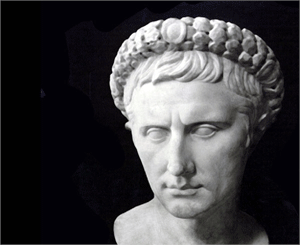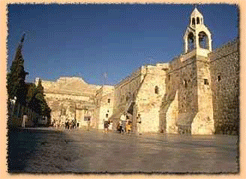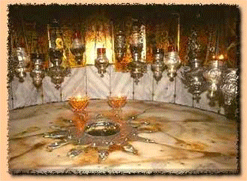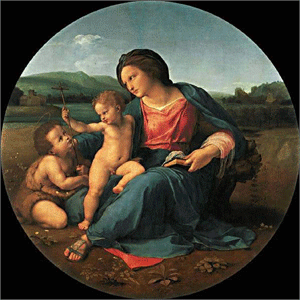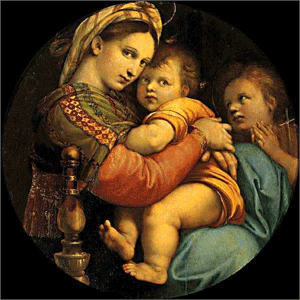
Christmas
Easter
Pentcoest
All Saints
Christ The King
Confirmation
Palm/Passion
Reformation
Stewardship
Books of the Bible
Lenten Series
Christmas Dramas
Videos
Series A - Matthew
Series B - Mark
Series C - Luke
Series D - Other
To contact
Edward F. Markquart
info@sfs.com
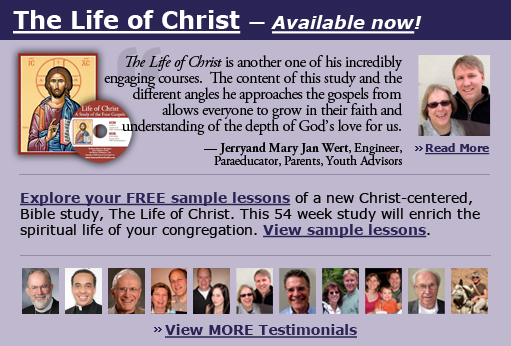
Series B Luke 2:1-14, Pastor Edward F. Markquart The following Bible study is from a larger course entitled THE LIFE OF CHRIST: A Study in the Four Gospels. This 54 week course for the laity will be available for congregations in 2006. Basic text for the course: SYNOPSIS OF THE FOUR GOSPELS, Kurt Aland, English Edition, PP. 7-8. #7. THE BIRTH OF JESUS Luke 2:1-7. This is the text for Christmas Eve, ABC. -In those days a decree went out from Emperor Augustus that all the world should be registered. Luke is a historian and persistently gives us specific historical details e.g.the names of Caesar Augustus and Quirinius. Caesar Augustus lived from 63 BCE to 14 CE. http://en.wikipedia.org/wiki/Image:Aug11_01.jpg
The following is a quotation from a website: “Rome achieved great glory under Octavian/Augustus. He restored peace after 100 years of civil war; maintained an honest government and a sound currency system; extended the highway system connecting Rome with its far-flung empire; developed an efficient postal service; fostered free trade among the provinces; and built many bridges, aqueducts and buildings adorned with beautiful works of art created in the classical style. Literature flourished with writers including Virgil, Horace, Ovid, and Livy all living under the emperor's patronage. The empire expanded under Augustus with his generals subduing Spain, Gaul (now France), Panonia and Dalmatia (now parts of Hungary and Croatia). He annexed Egypt and most of southwestern Europe up to the Danube River. After his death, the people the Roman Empire worshipped Augustus as a god.” http://www.lucidcafe.com/library/95sep/augustus.html -This was the first registration/enrollment and was taken while Quirinius was governor of Syria. Enrollments were censuses for the purpose of taxation and drafting men into the military. Jews were not allowed to be part of the Roman military legions, and so this particular enrollment/census was purely for taxation purposes. Quirinius was a Jewish official from 10-7BCE although he did not become governor until 7 CE. The reference to Quirinius is another indication of the historical consciousness of Luke as Luke placed Jesus’ birth into the context of his contemporary history. Luke may not have been technically correct that Quirinius was actually governor on the date of Jesus' birth, but Quirinius was a Roman official soon to become govenor. -All went to their own towns to be registered. Joseph also went from the town of Nazareth in Galilee to Judea, to the city of David called Bethlehem, because he was descended from the house and family of David. Luke, the historian, also gives us specific geographic details e.g. the location of Nazareth and Bethlehem. These towns are located correctly according their geographic settings given in ancient maps. Justin Martyr, an early church father who lived in about 150 CE and was from the area near Bethlehem, reports to us that Jesus was born in a cave in Bethlehem. If a pilgrim visits Bethlehem today, that person will visit a cave beneath a church which was built in the fourth century by Constantine’s mother as a holy shrine to honor the birth of Jesus. In the corner of that cave is the location where St. Jerome is said to have translated the Bible into Latin in about the year 400 CE. A rock is polished by the adoring kisses of pilgrims through the centuries, and a gold star is inlaid in the floor of the cave to indicate where Jesus may have been born. -He went to be registered with Mary, to whom he was engaged and who was expecting a child. While they were there, the time came for her to deliver her child. -And she gave birth to her firstborn son and wrapped him in bands of cloth/swaddling clothes, and laid him in a manger, because there was no place for them in the inn. “Swaddling clothes” was “a long band of cloth” which was used to create a plain, one-foot square wrapping. It was a long strip-like bandage and was tied around the baby’s body. The swaddling cloth was another indication of the poverty of Mary and Joseph. The words e.g. “inn,” “swaddling clothes,” and “manger” are associated with poverty or a lower financial class, as is their “poor offering” of two doves and pigeons instead of a lamb at Mary’s rite of purification. “Laid him in a manger.” Mangers were feeding stalls or a feeding trough for animals. This is another indication that Jesus was born into poverty. "No place for him in the inn." In our modern mythologies of this scene, we imagine a small, poor hotel on the outskirts of town. Some Biblical scholars suggest that the inn was not a place of public accomodations like our modern hotels or public inns from centuries past. Rather, the inn was a small room for animals attached to a private house. Above that inn for animals, there was a small guest room for people. In other words, Mary and Joseph may have staying in a small guest room of a private home and that small guest room may have been above the pen where the animals stayed. All of these features of the story emphasize that Jesus was born in poverty. The following pictures are of the temple built above the traditional site of Jesus’ birth. The star in the floor of the third picture is the traditional site of Jesus’ birth. http://www.mustardseed.net/html/pbethld.html
THE FOLLOWING PORTRAITS OF THE CHRIST CHILD BY RAPHAEL ARE WONDERFULLY EXQUISITE. Using the link to these paintings, you can see several other portraits of Mary, the mother of Jesus. Raphael painted many portraits of Mary and this reveals how important the event was to him.
PAINTING AND IMAGINATION: MADONNA AND CHILD Honors to Mary and Jesus Children / RAFFAELO,16,ITA,MADONNA D'ALBA, http://membres.lycos.fr/imagedart/images/mt02a/index.htm
LUKE 2:8-20 -In that region there were shepherds living in the fields, keeping watch over their flock by night. In this era of history, shepherds were considered poor people. Jeremias, a fine New Testament scholar of the previous generation, said that the shepherds were an unrespectable group of people because they did not obey the details and intricacies of the Jewish law. The shepherds were always out in the fields, tending their sheep, rather than attending the Jewish synagogue/temple and following Jewish laws for worship. -Then an angel of the Lord stood before them, and the glory of the Lord shone around them, and they were terrified. In Luke's story of Jesus' birth, we have heard of an angel (in a vision) who appeared before Zechariah and also an angel who appeared to Mary. Angels were and still are messengers from God. This is the third time in the Lucan story that "an angel" has appeared with God's message. "The glory of God" refers to the shining Presence of God. People, when we are aware that we are experiencing a miracle, often feel feel in our hearts. -But the angel said to them, "Do not be afraid; for see—I am bringing you good news of great joy for all the people: These words are at the heart of the gospel and creates great joy inside of us. We are not to be afraid of our circumstances of life. The word “gospel” means “good news.” Circle the word, “you,” and remember that God is bringing good news for you and all people. "The good news" is the gospel and the gospel is the central, summary message of the Christian faith. The good news is Jesus. The good news is Jesus' death and resurrection. The good news is Jesus' gift of everlasting life. The good news is that Jesus is with us in all circumstances. The good news is that Jesus was and is the personification of forgiveness. The good news is that there is a true God. The good news is that God is not a figment of our imagination. The good news is that life and our life is not a random accident of nature but has purpose and is part of the greater purposes of God. The good news is Jesus. The purpose of the church is to bring the good news of Jesus to all people. -To you is born this day in the city of David a Savior, who is the Messiah, the Lord. Circle the word, “you.” The “you” is personal. In the Gospel of Luke, we have been slowly and gradually building towards a crescendo that God is the Lord. Now, for the first time in this Gospel, we clearly hear that Jesus Christ is Lord. Lord means “ruler,” and Christ is to be the ruler of our lives. Emporer Augustus is not lord but Jesus is Lord. -This will be a sign for you: you will find a child wrapped in bands of cloth and lying in a manger." Circle the word, “you,” two times. The magic and miracle of Christmas is to discover that the personal gift from God is for YOU. -And suddenly there was with the angel a multitude of the heavenly host, praising God and saying, -"Glory to God in the highest heaven, and on earth peace among those whom he favors!" Praise and peace. These two qualities are deep within the human spirit. Deep within the human spirit is a need to praise God. Deep within the human spirit is to find and live out the peace of God. God is forever giving us peace. Peace is found in the hearts of those who walk in the ways of the Lord. Peace is always a consequence of justice and righteousness. To use an analogy of a horse drawn sleigh, the two horses are named Justice and Righteousness and the sleigh pulled behind those horses is named Peace. Peace follows justice and righteousness. Peace is a consequence of justice and righteousness. -When the angels had left them and gone into heaven, the shepherds said to one another, "Let us go now to Bethlehem and see this thing that has taken place, which the Lord has made known to us." This sentence is an invitation for us to “go and see” what has happened. That is what this course is all about: “going and seeing” the story of Jesus as told in the four gospels. There weren’t any movies in Jesus’ day. A way of “going and seeing” what happened was by listening to the stories about him. -So they went with haste and found Mary and Joseph, and the child lying in the manger. -When they saw this, they made known what had been told them about this child; and all who heard it were amazed at what the shepherds told them. -But Mary treasured all these words and pondered them in her heart. Mary is the source of many of the birth stories. Mother Mary is the source, the fountain, the spring from which the stories about Jesus’ childhood flow. At the conclusion of her life, she will be entrusted to the disciple John. John and Mary will journey to Ephesus which will become the center of Christianity for a short time. Today, there are two monasteries in Ephesus, one dedicated to John and the other to Mary the mother of Jesus. -The shepherds returned, glorifying and praising God for all they had heard and seen, as it had been told them. That is what happens after Christmas: we are to return to our work glorifying and praising God for all we have heard and seen during this past Christmas season. DISCUSSION QUESTION: USING YOUR IMAGINATION, IF JESUS WAS BORN INTO TODAY’S MODERN WORLD, WHERE WOULD HE HAVE BEEN BORN? WHAT WOULD BE THE CIRCUMSTANCES OF HIS BIRTH? See the following website: http://www.sermonsfromseattle.com/christmas.htm In this website, there are ten Christmas sermons, six children's Christmas stories, and seven Christmas dramas.
|
